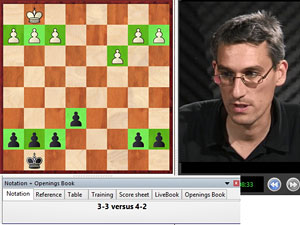The art of using your pawns
By Sagar Shah
At the recently concluded Tashir International tournament that was held in the memory of Tigran Petrosian, there occurred a beautiful game in the last round. It was the game between two of the best players in the world.
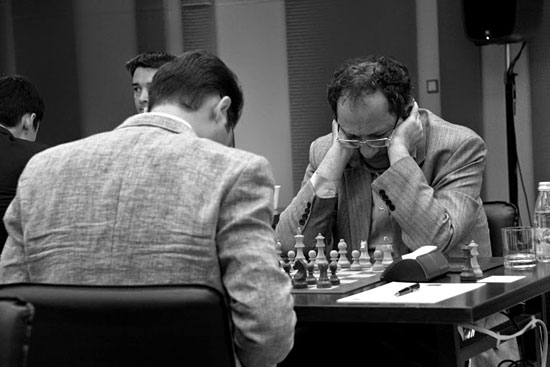
Boris Gelfand had the white pieces against Peter Leko
The game was a positional masterpiece by Boris. To outclass a player of Leko’s caliber from such an equal endgame is not an easy task. Gelfand not only managed to do it but did so in smooth fashion. Let’s have a look at this brilliant game.

[Event "Petrosian Memorial 2014"] [Site "Moscow RUS"] [Date "2014.11.11"] [Round "7.2"] [White "Gelfand, Boris"] [Black "Leko, Peter"] [Result "1-0"] [ECO "A35"] [WhiteElo "2759"] [BlackElo "2731"] [Annotator "Sagar Shah"] [PlyCount "34"] [EventDate "2014.11.04"] {I simply love this game for its simplicity and the ease with which Boris converts the small advantage into a win.} 1. Nf3 Nf6 2. c4 c5 3. Nc3 Nc6 4. g3 d5 5. d4 e6 6. cxd5 Nxd5 7. Bg2 cxd4 8. Nxd4 Nxc3 9. bxc3 Nxd4 10. Qxd4 (10. cxd4 {is also possible but it leads to much sharper lines after} Bb4+ 11. Kf1 $5 (11. Bd2 Qxd4 12. Bxb4 Qxb4+ {is an extra pawn for Black.})) 10... Qxd4 11. cxd4 Bb4+ 12. Bd2 Bxd2+ 13. Kxd2 {A pretty equal looking endgame has arisen, but there are a lot of imbalances. Firstly, White is better developed. His bishop is on an active diagonal and his rooks are connected. This should give him an edge. But as we know, being ahead in development is a short term advantage and if White is unable to do something concrete in the next few moves, his plus will count for nothing. On the other hand Black has a long term trump of having two pawns vs one on the queenside. A factor which could become important in the endgame.} Ke7 14. Rhc1 {Bringing the h-rook is more logical as the a-rook can make use of the b-file if required.} Rd8 15. Rc7+ Rd7 16. Rac1 Kd8 17. Rxd7+ Kxd7 (17... Bxd7 18. Bxb7 {is of course, bad.}) 1-0
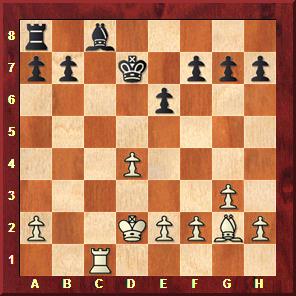
White is surely a tad better but how should he continue is the question.
Have a small think and then see how the Israeli player weaves his magic.

[Event "Petrosian Memorial 2014"] [Site "Moscow RUS"] [Date "2014.11.11"] [Round "7.2"] [White "Gelfand, Boris"] [Black "Leko, Peter"] [Result "1-0"] [ECO "A35"] [WhiteElo "2759"] [BlackElo "2731"] [Annotator "Sagar Shah"] [SetUp "1"] [FEN "r1b5/pp1k1ppp/4p3/8/3P4/6P1/P2KPPBP/2R5 w - - 0 18"] [PlyCount "39"] [EventDate "2014.11.04"] {Black's idea is obvious. He would like to play Rb8 followed by b6 and Bb7. In the meantime, White has to do something active.} 18. g4 $1 {Daniel King calls this move a cramping move. It is as if one pawn i.e the pawn on g4 cramps three black pawns: f7,g7,h7. g4 is a move that computers might not appreciate but it gains space and puts the pressure on the opponent.} (18. h4 {is also pretty good in this position because Black cannot play h5.} h5 {This is the most natural trying to stop White from expanding. But now White has a nice plan.} 19. Bf3 $1 {forcing Black to play g6 when his dark squares would be weakened.} g6 20. Ke3 {[%cal Ge3f4,Gf4g5,Gg5f6]} Rb8 21. Kf4 b6 (21... f6 22. Be4 $18) 22. Kg5 Bb7 23. Kf6 $18 {White king has made full use of all the dark squared weaknesses.}) 18... h6 19. h4 {gaining further space.} Rb8 20. f4 {and more space!} b6 21. Bc6+ Kd8 (21... Ke7 {A few months before this game was played, Radjabov played his king to e7 against Fressinet. But Leko plays the king to d8. Not much is changed.}) 22. e4 {[%csl Gd4,Ge4,Gf4,Gg4,Gh4] White pawns make a very nice impression.} Bd7 (22... Bb7 {will not change much. White will continue as in the game.}) 23. h5 $1 {Gaining further space and completely paralyzing the black pawn structure. One thing to note here is that Black's g7 pawn has been fixed. It cannot move. A move like g6 can be met with the very nice breakthrough g5! at the appropriate moment.} b5 (23... Rc8 {This is the most important question in this position. What is the result of the king and pawn endgame?} 24. Bxd7 Rxc1 25. Kxc1 Kxd7 {How do we assess this endgame? The main differentiating factor is the space advantage that White has in this position thanks to the moves g4,h4,f4,e4 and h5 that he played. Kingside tactical pawn breakthroughs will galore here and Black has to be extremely careful.} 26. e5 $1 {[%csl Ye5,Ye6,Yf4,Yf7,Yg4,Yg7,Yh5,Yh6] Diagram [#] This weird type of circular structure that I have marked in yellow is very interesting. The main point to note is that White has a lot of tactical ideas in such a structure. You will see more of it as we go deeper.} Kc6 (26... b5 27. Kc2 a5 28. Kc3 Kc6 29. f5 Kd7 30. d5 $1 $18) 27. f5 $1 (27. Kd2 Kd5 28. Kd3 b5 29. f5 f6 $1 $11 {Black defends the position.}) 27... Kd7 {The staunchest defence.} (27... Kd5 $2 28. f6 $1 gxf6 29. exf6 Kxd4 (29... Ke4 30. g5 Kf5 31. gxh6 Kxf6 32. a4 $18 {Black king has absolutely no moves and White will soon put him in zugzwang.}) 30. g5 $1 $18 {and there we have the final breakthrough. }) (27... exf5 28. gxf5 Kd5 29. Kc2 $18 {White will slowly march his king up the board while Black won't be able to do much.}) 28. Kd2 {As of now no breaks are available so let's bring the king.} f6 29. Ke3 (29. d5 exd5 30. e6+ Kc6 $11 {is just a draw.}) 29... fxe5 30. dxe5 Ke7 31. Kf4 (31. Ke4 Kf8 32. Kf4 Kf7 { and we reach the same position in the game.}) 31... Kf7 {It is important to understand that if the Black king were on e7 right now then White would have won the game with the g4-g5 breakthrough.} (31... a5 $2 32. Ke4 {[%cal Ge4d4, Gd4c4,Gc4b5]}) (31... b5 $2 32. Ke4 $18 {[%cal Ge4d4,Gd4c5]}) 32. Ke4 $1 {is the correct way to win this position.} (32. g5 $2 {With the black king on f7 this is a mistake. We need the black king to be on e7 when we make this move.} exf5 33. Kxf5 b5 34. e6+ Ke7 35. gxh6 gxh6 36. Ke5 a5 37. Kd5 b4 38. Kc5 Kxe6 $11) (32. -- {making a null move to prove my point that when the black king is on e7, g4-g5 will win the game.} Ke7 33. g5 exf5 34. Kxf5 b5 (34... Kf7 35. e6+ Ke7 36. Kg6 $1 hxg5 37. Kxg5 Kxe6 38. Kg6 $18) 35. gxh6 gxh6 36. Kg6 a5 37. Kxh6 b4 (37... Kf7 38. Kg5 b4 39. h6 a4 40. h7 Kg7 41. e6 b3 42. axb3 axb3 43. e7 b2 44. h8=Q+ Kxh8 45. e8=Q+ $18) 38. Kg7 a4 39. h6 b3 40. axb3 axb3 41. h7 b2 42. h8=Q b1=Q 43. Qf8+ Kd7 44. Qf7+ Kd8 (44... Kc6 45. Qg6+ $18) 45. e6 $18) 32... Ke7 33. Kd4 (33. Ke3 Ke8 34. Kf4 Kf7 {and it is not so easy to win by triangulation as Black also has waiting moves.}) 33... Kf7 (33... a6 34. Ke4 Kf7 35. Kf4 {a5 or b5 will create a weakness that the White king will go and attack and hence the black king has to move.} Ke7 36. g5 $1 $18 {as we have already seen above wins.}) 34. Kc4 a6 35. Kd4 Ke7 36. Ke4 Kf7 (36... Ke8 37. fxe6 $18) 37. Kf4 Ke7 38. g5 $18 {And White has successfully engineered the breakthrough.}) 24. Bxd7 Kxd7 25. Rc5 Rb6 26. Kc3 {The king has to be stopped from coming to b4.} a5 (26... a6 27. e5 {[%cal Gc3b4] preventing Rd6 and now threatening Kb4.} (27. Kb4 Rd6) 27... a5 {anyway has to be played.}) 27. e5 { Before undertaking anything, White takes away the d6 square from the rook.} g6 {Peter could take it no longer and decides to take some active measures but now it's all over.} 28. hxg6 fxg6 29. a4 $5 (29. d5 $5 {had better winning chances.} exd5 30. Rxd5+ Ke6 31. Kd4 a4 32. Kc5 Rb8 (32... b4 33. f5+ $18) 33. Rd6+ Kf7 34. Ra6 Re8 {with the idea of g5.} 35. Kxb5 g5 36. Rf6+ Kg7 37. Kxa4 gxf4 38. Rxf4 Rxe5 39. Kb4 $18) 29... b4+ (29... h5 30. gxh5 gxh5 31. axb5 $16) 30. Kb3 Ra6 31. f5 (31. d5 exd5 32. f5 (32. Rxd5+ Ke6 $11) 32... gxf5 33. gxf5 h5 34. Rxd5+ Ke7 $16 {Whether white is winning or not is unclear but he is definitely better.}) 31... gxf5 32. gxf5 exf5 33. d5 h5 $2 (33... f4 $1 34. Rc4 Ra8 35. Rxf4 Rc8 36. Rf7+ Ke8 37. Rb7 Rc3+ 38. Kb2 Re3 39. e6 h5 $132 {It seems as if Black has enough counterplay to hold the draw.}) 34. e6+ Kd6 35. Kc4 Ke5 (35... f4 36. Rc8 Ra7 37. Kd4 f3 38. Rc6+ Ke7 39. Ke5 f2 40. Rc8 Ra6 41. d6+ Rxd6 42. Rc7+ $18) 36. e7 {finishes the game!} Ra8 37. Rc6 $18 {A beautiful practical endgame. Boris played really well making use of his pawns in the best possible manner. He gained space, created his chances and put pressure on Leko. Computers may defend this position with 100% accuracy but for humans being tortured passively is not something that they enjoy. They try to break free and that's where you get your chance!} 1-0
The above analysis might seem long and tedious but going over it carefully will surely improve your endgame understanding

Delightful endgame play by Boris Gelfand
From the above analysis two positions stood out for me:

The five White pawns gobbling up all the space on the kingside

This circular formation which can lead to very tricky pawn breakthroughs for White
Boris made excellent use of his pawns in the endgame. Starting from the move 18.g4, he was able to control almost the entire kingside using his pawns. Pawn play is a very important factor if you want to become a good endgame player and a good chess player in general. It is more subtle than learning tactics and computers (engines) are sometimes clueless regarding it. So how do we go about improving our understanding of pawns?
There are a lot of books out there, the most popular one being “Pawn Power in Chess” by Hans Kmoch. However, there is one DVD which I would whole heartedly recommend to each and every player below the Elo of 2200. It is “Power Play 5” by GM Daniel King.
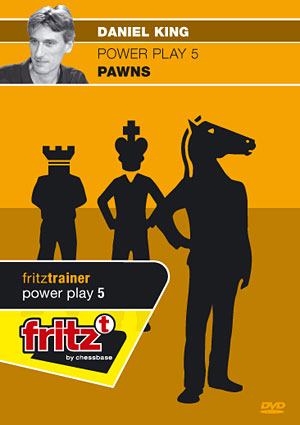
The “Power Play 5 – Pawns” is an old DVD that was released in 2007 but it is one of those timeless classics. The DVD starts off with the following test position:

The above position was reached after 22 moves in the game between Ulf Andersson (an endgame
virtuoso) and Robert Huebner. The question asked by Daniel King: What should White play?
I was watching this DVD towards the end of 2007 when I was rated around 2200 and to tell you the truth I stared at this position for nearly an hour unable to understand what exactly White should be doing. The answer was a complete revelation and taught me the art of using my pawns which was unknown to me at that point.
Another very important topic which Danny covers in this DVD is the pawn structure of 3-3 versus 4-2.
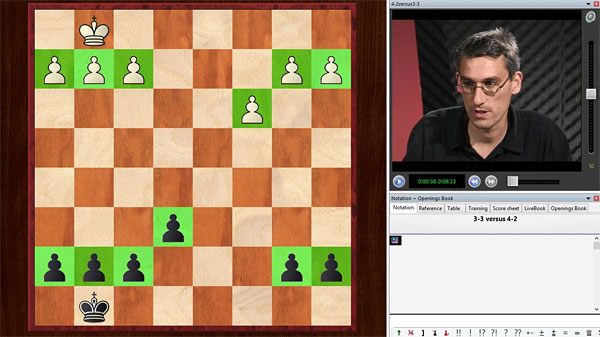
The 3-3 versus 4-2 structure arises from various openings and hence,
knowledge of how to play them from either side can be very useful.
I really benefited from this section of the DVD, and whenever such a pawn structure has arisen I have more often than not known what is to be done. My handling of such structures improved and, it goes without saying, so have my results.
By giving you examples from games of great players like Capablanca, Alekhine, Botvinnik, Petrosian, Gligoric, Andersson, Kramnik, Dvoretsky and many more top players, Daniel King covers variety of topics like weak pawns, minority attack, crippling pawns, cramping pawns and much more.

Games of top class players + explanations by Daniel King is a sure-shot way to improvement
It is a DVD that prepares you for the different pawn structures that will keep on arising in your chess games. I have seen many ChessBase DVDs in my life but “Power Play 5-Pawns” remains closest to my heart and one from which I have learnt the most.
 |
Daniel King: Power Play 5 - Pawns
- English
- With interactive training including video feedback
- Database with analysis and 50 selected GM games
- Including CB 12 Reader
Price: €29.99
€25.20 without VAT (for Customers outside the EU)
$31.38 (without VAT)
EAN: 402797500500 3
This DVD can be purchased as a hard copy or it can be downloaded directly from the Internet, that way sparing you the few days needed for it to arrive by post.
Order this Fritztrainer in the ChessBase Shop
|
Other Fritztrainer DVDs by Danial King
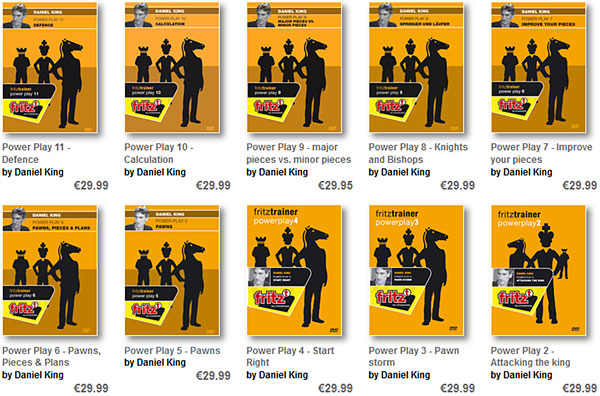
Browse and order your Daniel King Fritztrainers here
